Hypothermia vs Frostbite: Understanding Cold-Related Health Risks
What are the key differences between hypothermia and frostbite. How can you recognize the symptoms of these cold-related conditions. What immediate steps should be taken if someone shows signs of hypothermia or frostbite. How can these dangerous cold weather health risks be prevented.
What is Frostbite and How Does it Occur?
Frostbite is a cold-related injury that occurs when skin and underlying tissues freeze due to exposure to extremely cold temperatures. It most commonly affects extremities like fingers, toes, nose, ears, cheeks, and chin. Frostbite can cause permanent tissue damage in severe cases, potentially leading to amputation.
Frostbite develops in stages as the skin and deeper tissues freeze:
- First-degree (frostnip): Skin becomes red and numb
- Second-degree: Skin blisters after rewarming
- Third-degree: Skin and subcutaneous tissues freeze
- Fourth-degree: Muscles, tendons, and bones freeze
The risk of frostbite increases in windy conditions due to wind chill effect. People with poor circulation or those not dressed appropriately for the cold are at higher risk.

What are the Signs and Symptoms of Frostbite?
Recognizing frostbite early is crucial for preventing severe tissue damage. Common signs and symptoms include:
- Cold, prickling feeling in affected area
- Numbness
- Red, white, bluish-white or grayish-yellow skin
- Hard or waxy-looking skin
- Clumsiness due to joint and muscle stiffness
- Blistering after rewarming, in severe cases
Is frostbite always visible? Not always. In early stages, frostbite may only cause numbness without visible skin changes. As it progresses, skin color and texture changes become apparent.
Understanding Hypothermia: A Potentially Life-Threatening Condition
Hypothermia occurs when the body loses heat faster than it can produce it, causing a dangerously low body temperature. Normal body temperature is around 98.6°F (37°C). Hypothermia is medically defined as a core body temperature below 95°F (35°C).
Unlike frostbite, which affects specific body parts, hypothermia impacts the entire body and can be life-threatening. It affects the brain, impairing a person’s ability to think clearly or move properly. This makes hypothermia particularly dangerous, as victims may not realize what’s happening or be able to seek help.

Who is at Risk for Hypothermia?
Hypothermia can occur in various situations, not just in extreme cold. Those at higher risk include:
- Elderly individuals with inadequate food, clothing, or heating
- Infants sleeping in cold rooms
- People remaining outdoors for extended periods (homeless, hikers, hunters)
- Individuals under the influence of alcohol or drugs
- People with certain medical conditions like hypothyroidism or severe arthritis
- Anyone immersed in cold water
Can hypothermia occur in mild temperatures? Yes, hypothermia can occur even at cool temperatures above 40°F (4°C) if a person becomes chilled from rain, sweat, or submersion in cold water.
Recognizing the Symptoms of Hypothermia
Hypothermia symptoms can vary depending on the severity of the condition. It’s crucial to recognize these signs early, as severe hypothermia can lead to unconsciousness and death.
Symptoms in Adults
- Shivering (which may stop as hypothermia progresses)
- Exhaustion or feeling very tired
- Confusion
- Fumbling hands, loss of coordination
- Memory loss
- Slurred speech
- Drowsiness
Symptoms in Infants
- Bright red, cold skin
- Very low energy
- Weak cry
- Poor feeding
Why does shivering stop in severe hypothermia? As the body’s core temperature drops, it loses the ability to generate heat through shivering. This is a dangerous sign indicating severe hypothermia.
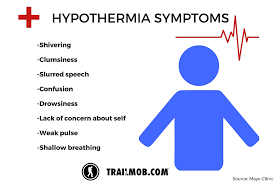
Immediate Actions for Frostbite and Hypothermia
Knowing how to respond quickly to signs of frostbite or hypothermia can prevent severe complications and potentially save lives.
First Aid for Frostbite
- Get the person to a warm area immediately
- Remove wet or tight clothing that may cut off blood flow
- Immerse the affected area in warm (not hot) water (104-108°F or 40-42°C)
- Alternatively, use body heat to warm the area (e.g., place frostbitten fingers in the armpit)
- Do not rub or massage the frostbitten area
- Avoid using heating pads, heat lamps, or the heat of a stove or fireplace
- Seek medical attention as soon as possible
First Aid for Hypothermia
- Call emergency services immediately
- Move the person to a warm, dry area
- Remove any wet clothing
- Warm the center of the body first (chest, neck, head, groin)
- Use skin-to-skin contact under loose, dry layers of blankets, clothing, or towels
- If conscious, give warm beverages, but avoid alcohol
- Once body temperature has increased, keep the person dry and wrapped in a warm blanket
- Seek medical attention as soon as possible
Why should you avoid rubbing frostbitten areas? Rubbing can cause further tissue damage. The goal is to gently warm the affected areas without causing additional harm.

Preventing Cold-Related Health Risks
Prevention is key when it comes to cold-related health risks. By taking proper precautions, you can significantly reduce your risk of developing frostbite or hypothermia.
Dress Appropriately
- Wear several layers of loose, warm clothing
- Choose moisture-wicking inner layers to keep skin dry
- Wear a hat, gloves, and waterproof boots
- Cover all exposed skin when venturing outdoors in very cold temperatures
Stay Dry
- Remove wet clothing immediately
- Keep your hands and feet dry, as wet skin freezes more quickly
Limit Time Outdoors
- Check the weather forecast and wind chill before going outside
- Limit your time outdoors in very cold, wet, or windy weather
- Seek shelter and warm up at regular intervals if you must be outside for extended periods
Stay Hydrated and Nourished
- Drink plenty of fluids, as dehydration increases the risk of cold injury
- Eat regular meals to help your body produce heat
- Avoid alcohol, as it causes your body to lose heat more rapidly
How does alcohol consumption increase the risk of hypothermia? Alcohol dilates blood vessels, increasing heat loss from the skin, and impairs the body’s ability to shiver and generate heat.

The Role of Wind Chill in Cold Weather Health Risks
Wind chill is an important factor in cold weather health risks. It describes how cold the air feels on exposed skin due to the combination of air temperature and wind speed. As wind speed increases, it draws heat from the body, making the air feel colder than the actual temperature.
For example, if the air temperature is 0°F (-18°C) and the wind speed is 15 mph, the wind chill temperature is -19°F (-28°C). This means your body loses heat as if the temperature were -19°F.
Understanding Wind Chill Charts
Wind chill charts provide valuable information for assessing the risk of frostbite:
- Wind chill of -15°F to -30°F: Frostbite possible within 30 minutes
- Wind chill of -30°F to -50°F: Frostbite possible within 10 minutes
- Wind chill of -50°F to -60°F: Frostbite possible within 5 minutes
Why is wind chill important for preventing cold-related injuries? Wind chill gives a more accurate representation of how cold it really feels and how quickly frostbite can occur, allowing people to take appropriate precautions.

Special Considerations for Vulnerable Populations
Certain groups are at higher risk for cold-related health problems and require special attention during cold weather.
Elderly Individuals
- May have reduced ability to sense temperature changes
- Often have chronic medical conditions that increase risk
- May have limited mobility, making it harder to stay active and warm
Children
- Lose heat from their bodies more quickly than adults
- May not recognize the dangers of cold weather
- Often stay outside playing longer, increasing exposure risk
People with Chronic Medical Conditions
- Conditions like diabetes, thyroid problems, and Raynaud’s syndrome can increase cold sensitivity
- Certain medications can affect the body’s ability to regulate temperature
Homeless Individuals
- Prolonged exposure to cold due to lack of shelter
- May have inadequate clothing and nutrition
- Often have underlying health issues that increase risk
How can communities support vulnerable populations during cold weather? Communities can establish warming centers, conduct welfare checks on elderly residents, and provide emergency shelter and supplies for homeless individuals.

Long-Term Effects and Complications of Cold-Related Injuries
While immediate treatment is crucial for frostbite and hypothermia, these conditions can also have long-lasting effects on health.
Long-Term Effects of Frostbite
- Increased sensitivity to cold
- Chronic pain in affected areas
- Numbness or reduced sensation
- Changes in skin color
- Nail deformities or loss
- Joint stiffness and arthritis
- Growth defects in children (if growth plates are affected)
- In severe cases, amputation may be necessary
Long-Term Effects of Hypothermia
- Kidney problems
- Liver damage
- Heart problems, including arrhythmias
- Pneumonia
- Neurological issues, including memory problems
Can frostbite cause permanent nerve damage? Yes, severe frostbite can cause permanent nerve damage, leading to chronic pain, numbness, or altered sensation in the affected areas.
The severity of long-term effects often correlates with the severity of the initial injury and how quickly treatment was received. This underscores the importance of prevention and prompt treatment for cold-related injuries.

Understanding the risks associated with cold weather, recognizing the signs of frostbite and hypothermia, and knowing how to respond can help prevent these potentially life-threatening conditions. By taking proper precautions and being prepared, you can safely enjoy winter activities and weather.
Frostbite and Hypothermia
Frostbite and Hypothermia
Being exposed to cold temperatures for a long period of time can lead to serious health problems. The most common cold weather illnesses are frostbite and hypothermia. Below is general safety information and related resources to keep you safe.
Frostbite
Frostbite is an injury to the body that is caused by freezing. Frostbite causes a loss of feeling and color in affected areas. It most often affects the nose, ears, cheeks, chin, fingers, or toes. Frostbite can permanently damage the body, and severe cases can lead to amputation. The risk of frostbite is increased in people with reduced blood circulation and among people who are not dressed properly for extremely cold temperatures.
Signs of frostbite:
What to do:
Get into a warm room as soon as possible.
Unless absolutely necessary, do not walk on frostbitten feet or toes—this increases the damage.

Immerse the affected area in warm—not hot—water (the temperature should be comfortable to the touch for unaffected parts of the body).
Or, warm the affected area using body heat. For example, the heat of an armpit can be used to warm frostbitten fingers.
Do not rub the frostbitten area with snow or massage it at all. This can cause more damage.
Don’t use a heating pad, heat lamp, or the heat of a stove, fireplace, or radiator for warming. Affected areas are numb and can be easily burned.
Seek medical treatment
More on frostbite En Español
Hypothermia
Hypothermia is more serious than frostbite. When exposed to cold temperatures, your body begins to lose heat faster than it can be produced. Prolonged exposure to cold will eventually use up your body’s stored energy. The result is hypothermia, or abnormally low body temperature. Body temperature that is too low affects the brain, making the victim unable to think clearly or move well. This makes hypothermia particularly dangerous because a person may not know it is happening and won’t be able to do anything about it.
The result is hypothermia, or abnormally low body temperature. Body temperature that is too low affects the brain, making the victim unable to think clearly or move well. This makes hypothermia particularly dangerous because a person may not know it is happening and won’t be able to do anything about it.
Hypothermia is most likely at very cold temperatures, but it can occur even at cool temperatures (above 40°F) if a person becomes chilled from rain, sweat, or submersion in cold water. Victims of hypothermia are often (1) elderly people with inadequate food, clothing, or heating; (2) babies sleeping in cold bedrooms; (3) people who remain outdoors for long periods—the homeless, hikers, hunters, etc.; and (4) people who drink alcohol or use illicit drugs.
Signs of hypothermia:
Adults
shivering, exhaustion
confusion, fumbling hands
memory loss, slurred speech
drowsiness
Infants
bright red, cold skin
very low energy
More on hypothermia En Español
What To Do
If you notice any of these signs, take the person’s temperature. If it is below 95°, the situation is an emergency—get medical attention immediately.
If it is below 95°, the situation is an emergency—get medical attention immediately.
If medical care is not available, begin warming the person, as follows:
Get the victim into a warm room or shelter.
If the victim has on any wet clothing, remove it.
Warm the center of the body first—chest, neck, head, and groin—using an electric blanket, if available. Or use skin-to-skin contact under loose, dry layers of blankets, clothing, towels, or sheets.
Warm beverages can help increase the body temperature, but do not give alcoholic beverages. Do not try to give beverages to an unconscious person.
After body temperature has increased, keep the person dry and wrapped in a warm blanket, including the head and neck.
Get medical attention as soon as possible.
Back to Cold Weather Main Page
For more winter safety information be sure to follow CTDPH on social media.
To request your free CT Guide to Emergency Preparedness call 860 509-7599
The Differences Between Frostbite and Hypothermia
Frostbite and hypothermia are both associated with very cold weather. While the weather conditions that cause them are the same, their effects on the body are different.
Feb. 3, 2023
The winter months in New York can get very cold – sometimes dangerously so. In February 1979, the Adirondack town of Old Forge set an all-time low record temperature for the state at -52°F.
While a new record low temperature does not appear to be in store so far this winter, people who are outside or lacking heat in single-digit or subzero temperatures are at risk for frostbite and hypothermia if they stay out too long without proper winter apparel.
Ryan Buryta, DO, is the Associate Medical Director of Adult Emergency at Rochester General Hospital, and treats patients with hypothermia and frostbite.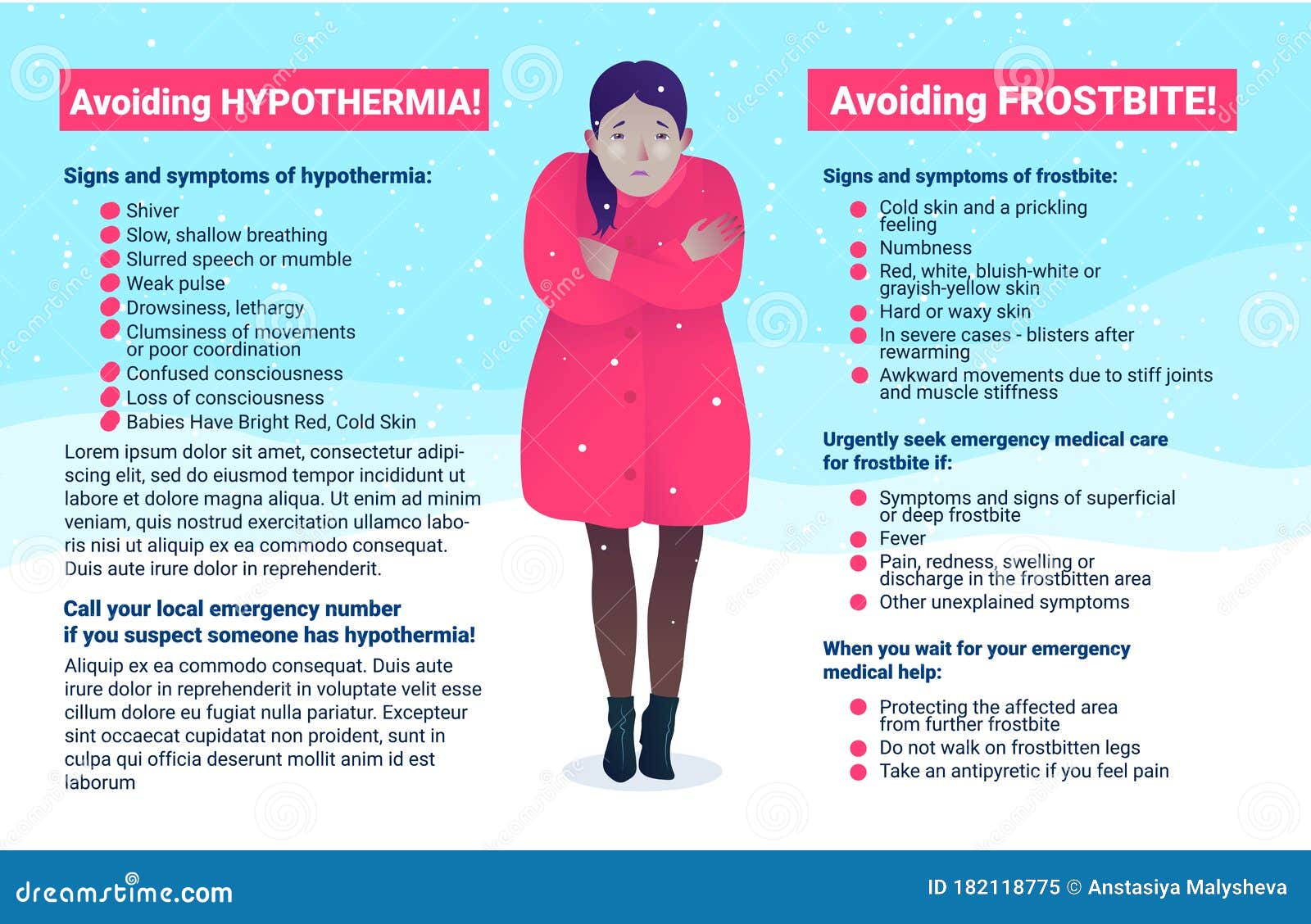 He explains the differences in symptoms, diagnosis, and treatments for both conditions.
He explains the differences in symptoms, diagnosis, and treatments for both conditions.
Frostbite
Frostbite is an injury that happens to the skin when it is exposed to extreme cold temperatures. The skin freezes, causing a loss of feeling and color.
Areas of the skin that are typically exposed to the winter elements include the cheeks, nose, chin, fingers, and toes.
Symptoms
The initial signs of frostbite are numbness and skin that starts to feel more firm or waxy. If the skin begins to turn white or a gray/yellow color, frostbite may be setting in.
According to the CDC, a person with frostbite may not be able to feel their own skin because their sense of touch is dulled by the extreme cold temperatures.
“It’s important to know the initial symptoms of frostbite because it is reversible,” Dr. Buryta said. “If someone is having early signs of frostbite, this is initially reversible. When the symptoms become more severe, the effects become irreversible. ”
”
Treatment
To counteract the symptoms of frostbite, head indoors to a warm area as quickly as possible. Avoid walking on feet or toes that may have frostbite; do not massage any affected skin, either. Additional pressure can further damage the affected part of the body.
Putting the affected area in warm water can help to restore circulation without damaging the skin. Contact a healthcare provider as soon as possible to seek medical care.
Avoid warming the skin too quickly with a heat source such as a heating pad, heat lamp, stove or fireplace. This might cause burning.
Hypothermia
Hypothermia is a life-threatening condition that happens when a person’s core body temperature becomes abnormally cold due to exposure to extreme cold.
The longer a person is exposed to extreme cold temperatures, the longer their body loses the heat it produces. People who are older and lack adequate shelter, food, or clothes are at risk of hypothermia, along with babies sleeping in cold rooms and people drinking alcohol or using illicit drugs, according to the CDC.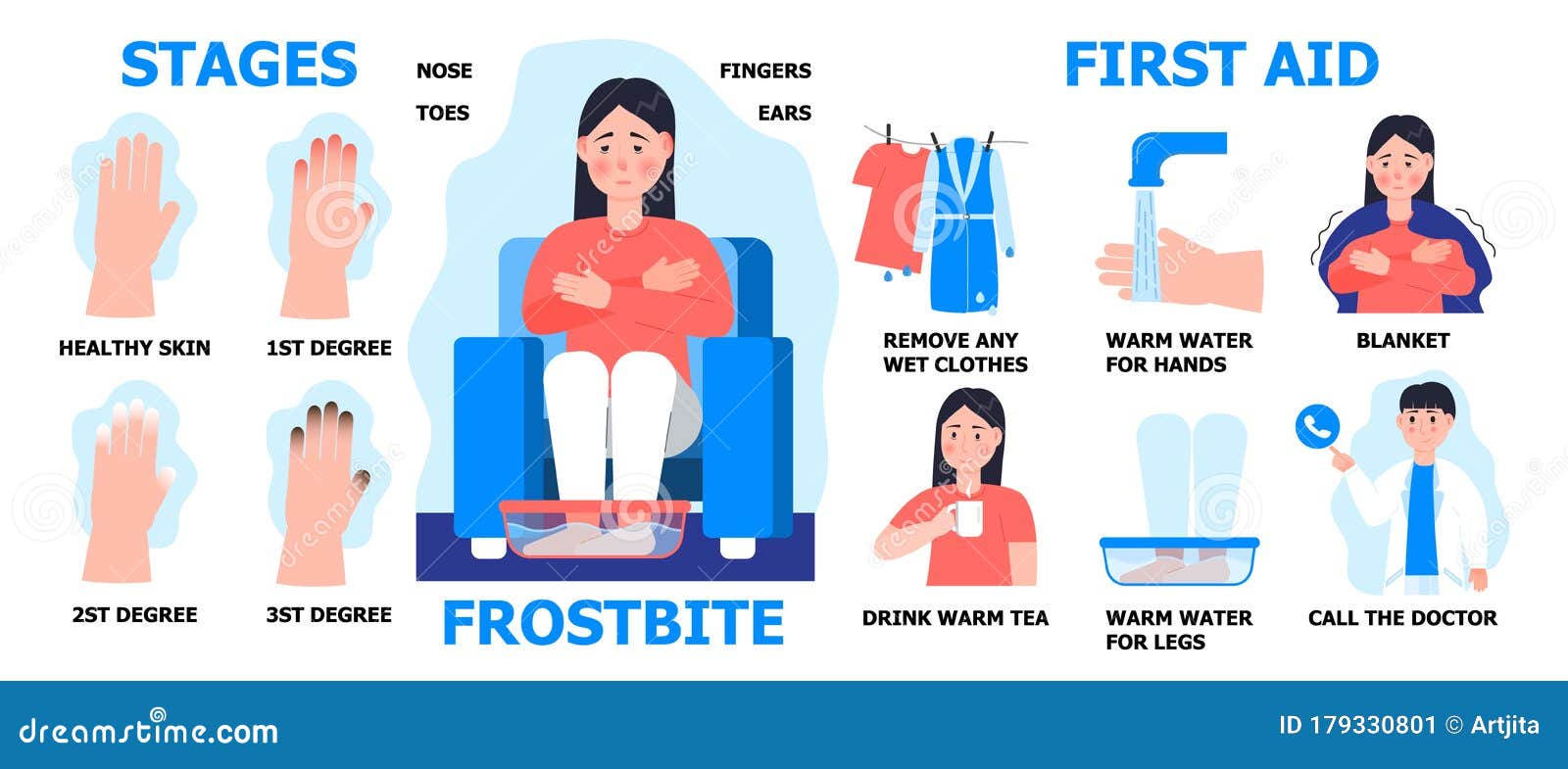
Symptoms
Children and adults show signs of hypothermia differently.
Children will have bright red skin that feels cold and act lethargic, while adults will begin to act confused, slur their speech and become drowsy or lethargic. Intense shivering is often an early warning sign of hypothermia.
Treatment
The first thing a person should do if they are exhibiting signs of hypothermia is to head indoors, if they are not already. Once inside, they can remove all damp clothing, put in dry clothing, and wrap themselves in dry blankets or sheets.
If a person has severe hypothermia, they may be unconscious or fade in and out of consciousness.
“Hypothermia has the potential to be a life-threatening condition,” Dr. Buryta said. “If a person is showing any of the symptoms of hypothermia, call 911 for professional medical attention as quickly as possible.”
NEXT STEPS
Emergency Medical Care
When you need emergency care immediately, our emergency medicine teams are ready to help with whatever you need.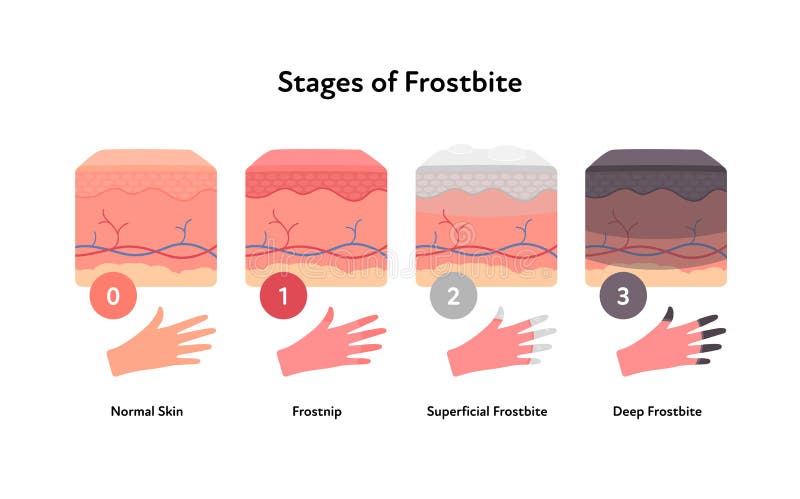 We work to provide the highest-quality patient care possible from the moment you come to us.
We work to provide the highest-quality patient care possible from the moment you come to us.
Learn More
Frostbite First Aid – First Aid
Signs of hypothermia of the victim
There are complaints of feeling cold, trembling, chills (in the initial stage of hypothermia). In the future, lethargy appears, the will to save is lost, a decrease in pulse and respiration appears.
With continued hypothermia, consciousness is lost, the pulse slows down to 30-40 per minute, and the number of breaths is up to 3-6 times per minute. Hypothermia can be combined with frostbite, which should be taken into account when providing first aid.First aid for hypothermia with frostbite
Change the victim’s clothes to warm and dry, wrap him with improvised means (for example, a blanket), move him to a warmer room, give him a warm drink (if he is conscious).
 Indoors, warming can be carried out in the form of warm air baths (direct a stream of warm air to the victim).
Indoors, warming can be carried out in the form of warm air baths (direct a stream of warm air to the victim).Presence of a rescue isothermal blanket
If you have a rescue isothermal blanket (included in the first aid kit for workers), it is necessary to wrap the victim with the silver side inside, leaving the face free.
Severe hypothermia
In case of severe hypothermia, it is necessary to control the condition, be ready to conduct cardiopulmonary resuscitation in the amount of pressure with the hands on the chest of the victim and breaths of artificial respiration.
Severe frostbite
With severe frostbite, a “wooden sound” may appear when a finger is tapped on an injured limb, impossibility or difficulty in moving in the joints.
 Some time after warming, pain, swelling, redness with a bluish tint, blisters appear on the affected limb.
Some time after warming, pain, swelling, redness with a bluish tint, blisters appear on the affected limb.
Frostbite First Aid:
Immediately cover injured limbs and parts of the body with heat-insulating material (cotton wool, blanket, clothing) or apply a heat-insulating bandage (using improvised means), because. warming should occur “from the inside” with the simultaneous restoration of blood circulation.
It is necessary to create immobility of the damaged part of the body, move the victim to a warm room, give a warm drink. The affected areas should not be actively warmed (dipped in hot water), rubbed, massaged, lubricated with anything.
Download video
Share:
Other articles
Extraction and movement of the victim
Optimal body position of the victim
First aid for general hypothermia
Is this article helpful?
78% of visitors find the article helpful
Yes
No
How to avoid hypothermia and frostbite
The risk of frostbite, that is, damage to a part of the body up to necrosis under the influence of low temperatures, occurs:
- at temperatures below -10 °C;
- at temperatures above -10 °C in case of prolonged exposure to the open air, high humidity and strong wind.

Factors that increase the risk of frostbite:
- tight and wet shoes;
- physical fatigue;
- hunger;
- forced prolonged immobility and uncomfortable position;
- previous cold injury;
- weakening of the body as a result of previous diseases;
- sweating of the feet;
- chronic diseases of the vessels of the lower extremities and the cardiovascular system;
- severe mechanical damage with blood loss;
- smoking etc.
Basic steps to avoid hypothermia and frostbite
- Find out the forecast in advance and choose the right clothes for the weather (in windy weather, wear windproof outerwear, in damp weather – waterproof, in cold weather – woolen, multi-layered like a “thermos” to warm air was kept between the folds of clothing).
- Eat warm food before going out.
- Be active outdoors.
- If possible, use wool socks, except cotton ones – wool absorbs moisture, leaving the skin dry.

- Avoid alcohol and psychotropic substances. Any intoxication creates an illusion of warmth, slows down reactions, reduces the possibility of concentration.
- Try not to smoke in the cold, as during smoking, vasospasm occurs, blood flow to the extremities decreases.
- Cover exposed areas of the body – use mittens, scarves, hats, or try to lubricate exposed areas of the body with a fat cream that does not contain water.
- Avoid skin contact with metal outdoors.
Signs of frostbite and general hypothermia:
- pale bluish skin;
- temperature, tactile and pain sensitivity is absent or sharply reduced;
- when warming up, severe pain, redness and swelling of soft tissues appear;
- with deeper damage, blisters with bloody contents may appear after 12–24 hours;
- with general hypothermia, a person becomes lethargic, indifferent to the environment, his skin is pale, cold, his pulse is frequent, blood pressure is reduced, body temperature is below 36 ° C.

First aid for hypothermia and frostbite
First aid varies depending on the degree of frostbite, general cooling of the body, age and diseases. First priority:
- Move victim to warm area;
- Remove frozen items: jacket, trousers, shoes, socks, mittens;
- Avoid sudden heating. At the first stage of frostbite, rub the frozen parts of the body to restore blood circulation. In other stages, rubbing will be harmful, as the cold has led to significant tissue damage. Visually it is difficult to determine the stage of frostbite, so it is better to allow the body to gradually warm up and restore blood circulation in the affected areas. Change the victim into dry warm clothes, wrap them with a blanket, wrap frostbitten areas of the body last. Give warm drinks to drink: tea, milk, broth;
- Call a doctor.
Avoid frostbite:
- Alcohol.
- Vigorous movements.
Not recommended: massage, rubbing with snow or wool, warm baths, heating pads, warm compresses, lubricating the skin with oils or fats.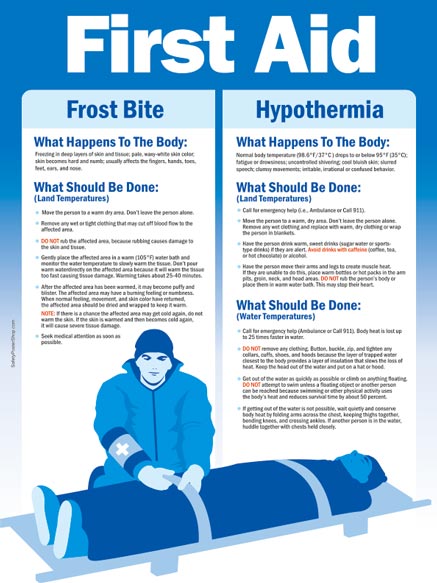


 Indoors, warming can be carried out in the form of warm air baths (direct a stream of warm air to the victim).
Indoors, warming can be carried out in the form of warm air baths (direct a stream of warm air to the victim).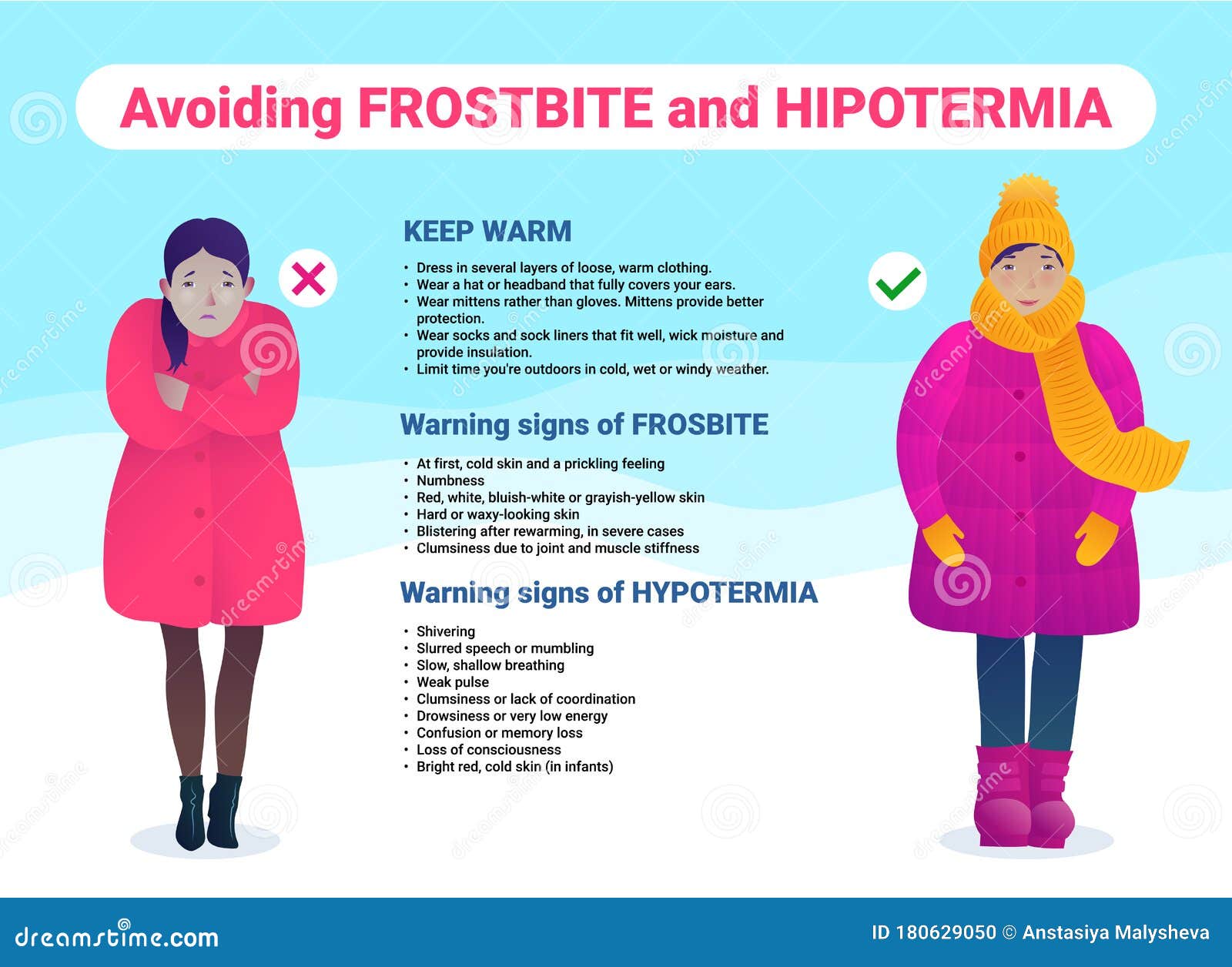 Some time after warming, pain, swelling, redness with a bluish tint, blisters appear on the affected limb.
Some time after warming, pain, swelling, redness with a bluish tint, blisters appear on the affected limb.

